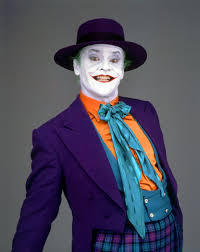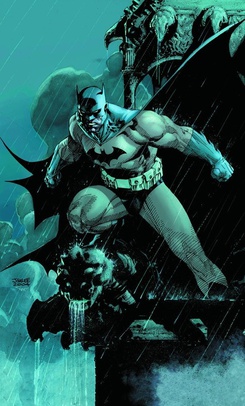
Batman is a superhero appearing in American comic books published by DC Comics. The character was created by artist Bob Kane and writer Bill Finger, and debuted in the 27th issue of the comic book Detective Comics on March 30, 1939. In the DC Universe continuity, Batman is the alias of Bruce Wayne, a wealthy American playboy, philanthropist, and industrialist who resides in Gotham City. Batman's origin story features him swearing vengeance against criminals after witnessing the murder of his parents Thomas and Martha as a child, a vendetta tempered with the ideal of justice. He trains himself physically and intellectually, crafts a bat-inspired persona, and monitors the Gotham streets at night. Kane, Finger, and other creators accompanied Batman with supporting characters, including his sidekicks Robin and Batgirl; allies Alfred Pennyworth, James Gordon, and Catwoman; and foes such as the Penguin, the Riddler, Two-Face, and his archenemy, the Joker.

Batman is a 1989 superhero film based on the DC Comics character of the same name, created by Bob Kane and Bill Finger. Directed by Tim Burton, it is the first installment of Warner Bros.' initial Batman film series. The film was produced by Jon Peters and Peter Guber and stars Jack Nicholson, Michael Keaton, Kim Basinger, Robert Wuhl, Pat Hingle, Billy Dee Williams, Michael Gough, and Jack Palance. The film takes place early in the title character's war on crime and depicts his conflict with his archenemy The Joker.
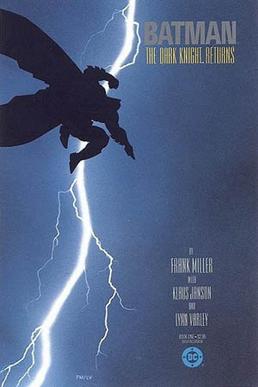
The Dark Knight Returns is a 1986 four-issue comic book miniseries starring Batman, written by Frank Miller, illustrated by Miller and Klaus Janson, with color by Lynn Varley, and published by DC Comics. It tells an alternative story of Bruce Wayne, who at 55 years old returns from retirement to fight crime while facing opposition from the Gotham City police force and the United States government. The story also features the return of classic foes Two-Face and the Joker, and culminates with a confrontation with Superman, who is now a pawn of the government.

The Joker is a supervillain appearing in American comic books published by DC Comics. Created by Bill Finger, Bob Kane, and Jerry Robinson, the character first appeared in the debut issue of the comic book Batman on April 25, 1940. Credit for the Joker's creation is disputed; Kane and Robinson claimed responsibility for his design while acknowledging Finger's writing contribution. Although the Joker was planned to be killed off during his initial appearance, he was spared by editorial intervention, allowing the character to endure as the archenemy of the superhero Batman.

Alfred Thaddeus Crane Pennyworth, originally Alfred Beagle and commonly known simply as Alfred, is a fictional character appearing in American comic books published by DC Comics, most commonly in association with the superhero Batman.

James W. "Jim" Gordon Sr. is a fictional character appearing in American comic books published by DC Comics, most commonly in association with the superhero Batman. Created by Bill Finger and Bob Kane as an ally of Batman, the character debuted in the first panel of Detective Comics #27, Batman's first appearance, making him the first Batman supporting character ever to be introduced.
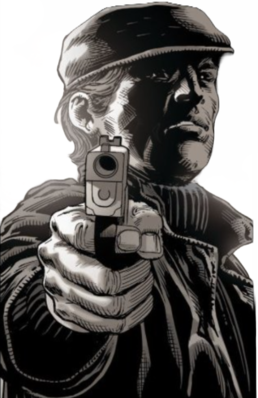
Joe Chill is a fictional character appearing in American comic books published by DC Comics, commonly in association with the superhero Batman. Created by Bill Finger and Bob Kane, the character first appeared in Detective Comics #33.

Thomas Alan Wayne, M.D. is a fictional character appearing in American comic books published by DC Comics. He is the father of Bruce Wayne (Batman), and husband of Martha Wayne as well as the paternal grandfather of Damian Wayne. Wayne was introduced in Detective Comics #33, the first exposition of Batman's origin story. A gifted surgeon and philanthropist to Gotham City, Wayne inherited the Wayne family fortune after Patrick Wayne. When Wayne and his wife are murdered in a street mugging, Bruce is inspired to fight crime in Gotham as the vigilante Batman.

The Dark Knight is a 2008 superhero film directed by Christopher Nolan from a screenplay co-written with his brother Jonathan. Based on the DC Comics superhero Batman, it is the sequel to Batman Begins (2005) and the second installment in The Dark Knight trilogy. The plot follows the vigilante Batman, police lieutenant James Gordon, and district attorney Harvey Dent, who form an alliance to dismantle organized crime in Gotham City. Their efforts are derailed by the Joker, an anarchistic mastermind who seeks to test how far Batman will go to save the city from chaos. The ensemble cast includes Christian Bale, Michael Caine, Heath Ledger, Gary Oldman, Aaron Eckhart, Maggie Gyllenhaal, and Morgan Freeman.

In addition to DC Comics books, the superhero Robin also appears in other media, such as films, television and radio. Dick Grayson, Jason Todd, Tim Drake, Stephanie Brown, and Damian Wayne are examples of the characters who use the name Robin.

The Batman franchise, based on the fictional superhero Batman who appears in American comic books published by DC Comics, has seen the release of various films. Created by Bob Kane and Bill Finger, the character first starred in two serial films in the 1940s: Batman and Batman and Robin. The character also appeared in the 1966 film Batman, which was a feature film adaptation of the 1960s Batman TV series starring Adam West and Burt Ward, who also starred in the film. Toward the end of the 1980s, the Warner Bros. studio began producing a series of feature films starring Batman, beginning with the 1989 film Batman, directed by Tim Burton and starring Michael Keaton. Burton and Keaton returned for the 1992 sequel Batman Returns, and in 1995, Joel Schumacher directed Batman Forever with Val Kilmer as Batman. Schumacher also directed the 1997 sequel Batman & Robin, which starred George Clooney. Batman & Robin was poorly received by both critics and fans, leading to the cancellation of Batman Unchained.

The Joker, a supervillain in DC Comics and archenemy of the superhero Batman, has appeared in various media. WorldCat records over 250 productions featuring the Joker as a subject, including films, television series, books, and video games. Live-action films featuring the character are typically the most successful.
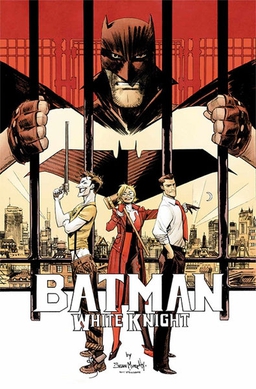
Batman: White Knight is an American comic book published by DC Comics. The eight-issue limited series, written and illustrated by Sean Murphy, began monthly publication in October 2017 and concluded in May 2018. In the series, the Joker is seemingly cured of his madness and sets out to become a politician under his real name of Jack Napier, seeking to change his public image as a "villain" and save Gotham City from Batman, whom he views as the real enemy of the city.

Batman: Curse of the White Knight is an American comic book published by DC Comics under its Black Label imprint. The eight-issue limited series, written and illustrated by Sean Murphy, began publication on July 24, 2019 and concluded on March 25, 2020. It is the sequel to Batman: White Knight and is the second installment in the Murphyverse's White Knight series, which takes place within a self-contained alternate reality that is different from and unrelated to the main DC Universe.

The origin of Batman depicts the events that cause a young Bruce Wayne to become Batman. The core event has remained fairly unchanged, but the aftermath and Bruce's journey to become Batman were not detailed until later years. The story first appeared in Detective Comics #33, and was retold in graphic novels such as Batman: Year One.
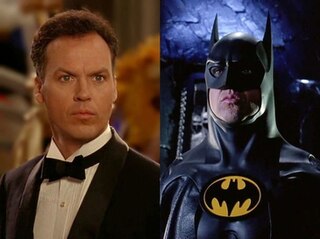
Bruce Wayne, better known by his vigilante superhero alias Batman, is a fictional character who is featured as the main protagonist in Warner Bros.' initial Batman film series (1989–1997), and later as a supporting character in the DC Extended Universe (DCEU) film The Flash (2023). Based on the DC Comics character of the same name, he was portrayed by Michael Keaton in Tim Burton's Batman (1989) and Batman Returns (1992), before being recast with Val Kilmer and George Clooney in Joel Schumacher's Batman Forever (1995) and Batman & Robin (1997) respectively.

The supervillain the Penguin, created by Bob Kane and Bill Finger, made his first appearance in Detective Comics #58. Since then, he has been adapted into other forms of media, including feature films, television series, and video games.

Bruce Wayne, also known by his vigilante persona Batman, is a fictional character who is the main protagonist in Christopher Nolan's trilogy of superhero films, based on the DC Comics character of the same name, created by Bill Finger and Bob Kane. Portrayed by Christian Bale, this version of Batman is arguably explored more in-depth compared to that of the previous film series by Tim Burton and Joel Schumacher, as the Dark Knight film series provides a full arc for the character and was intended by Nolan to be more realistic than previous portrayals.

Batman: Beyond the White Knight is an American comic book published by DC Comics under its Black Label imprint. The eight-issue limited series — written and illustrated by Sean Murphy, lettered by AndWorld Design and colored by Dave Stewart — began its monthly publication on March 29, 2022 and ended on February 14, 2023. It is the sequel to both Batman: White Knight (2017–18) and Batman: Curse of the White Knight (2019–20), and is also the fifth installment in Murphy's self-titled Murphyverse line. It is also an adaptation of the animated television series Batman Beyond (1999–2001), with the plot of the comic book being based on the original premise of the TV show.
